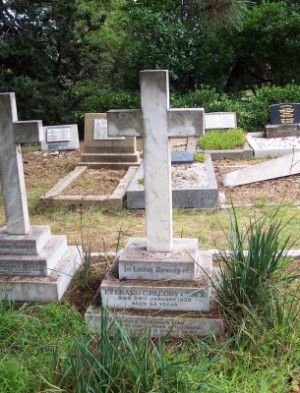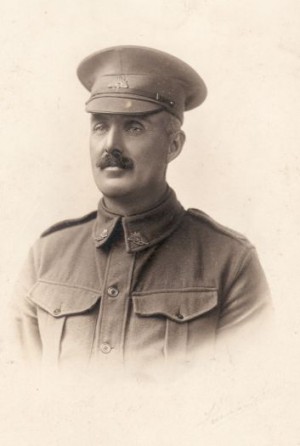Service Details
- Branch of Service
- Army
- Conflict
- World War I (1914-1918)
- Date of Enlistment
- 10/04/1917
- Date of Discharge
- 21/03/1919
- Place of Enlistment
- Queanbeyan NSW
Personal Details
- Gender
- Male
- Place of Birth
- Grandchester, Queensland
- Address (at enlistment)
- Gungahleen (Gungahlin) ACT
- Occupation
- Grazier
- Next of Kin
- Helen Crace (wife), Gungahleen ACT
Unit and Rank Details
- Service Number
- 6785
- Final Rank
- Private
- Final Unit
- 40 Battalion AIF
Commemoration
Belconnen Area Enlistments WW1, Ellen Clark Park, Smith Street, Weetangera
Hall Memorial Grove, Victoria Street, Hall ACT
Queanbeyan RSL Wall of Remembrance, Crawford St, Queanbeyan NSW
Memorial plaque in St John's Church, Reid ACT
Notes
Everard Crace, the eldest son of Edward and Kate Crace, was born at his grandparent's property Franklyn Vale near Grandchester in Queensland's Lockyer valley on 27 November 1874. His parents married in 1871 and Edward managed Franklyn Vale for his father in law from then until 1876 when he took his family to England. They returned to Australia the following year after he purchased Ginninderra and Gungahleen from William Davis. A few years later he also purchased Henry Hall's former property Charnwood meaning that he owned more than 20,000 acres of land in the Belconnen area.
Crace was working in a wool broking business in London when his father drowned in Ginninderra Creek in 1892. Although he was only 18 years old he was recalled to help his mother manage the heavily mortgaged Gungahleen in a period of economic depression in New South Wales. Following his marriage to Helen Blanch Lingen in December 1903 at St. Mark's in Darling Point, Sydney he seems to have made the old cottage at Ginninderra his family home while his mother occupied Gungahleen. Ginninderra was also known as Palmerville, the site of which is near the Belconnen Soccer Club in McKellar.
Crace served as a councillor for Yarrowlumla Shire and helped found the Ginninderra Farmers Union in 1905. At the outbreak of the war he organised patriotic sports days in Ginninderra and Canberra and presided over the launch of the Federal Capital Referendum Committee in support of conscription in 1916. That year the Commonwealth resumed Gungahleen but Crace continued to lease the property.
He clearly felt a responsibility to do more than provide support for the war so in April 1917 Crace enlisted in Queanbeyan. The day before he somewhat brazenly turned up the at annual Easter sports held at Tuggeranong in support of the local Catholic church and appealed to eligible young men to come forward and enlist as he was "looking for some mates to join the Sportsman's unit." None responded. Ted Shumack, who lived near him at Kia Ora, did enlist with him though. While most soldiers received a wristwatch or something similarly humble when they were farewelled, the squire of Gungahleen was presented with a six foot high hall clock at his send-off at the Kinlyside Hall in Hall.
The Sportsman's Unit was a recruiting tool reputedly organised by Olympic boxing silver medallist turned promoter, Reg 'Snowy' Baker. It was argued that many members of sports clubs would prefer to "mix and live and fight alongside other sportsmen" to help win "the Great Game". Hundreds of men, including Crace, were inspired to enlist and they became the 20th reinforcements to the 19th Battalion, embarking for England on 16 July 1917 and arriving in Liverpool two months later.
Crace was not only wealthier than most Australian soldiers but, at more than six feet tall and weighing over 190 pounds, he was also physically bigger as well. His age - he was in his 43rd year - counted against him though as the AIF found reasons to return older recruits back to Australia. Crace's obituaries say that he was declared medically unfit but that he chose to act as a battalion cook rather than be sent home. This he did, serving with the 40th Battalion as a cook in France from February 1918 until the end of the war.
After the war he became the first president of the Canberra Empire Service League and chaired a meeting on 27 September 1919 to form a branch of the Returned Sailors and Soldiers Imperial League of Australia. He died on 29 January 1928 at Gungahleen and is buried in St. John's Churchyard in Reid.
Description - height 6 feet 1 inches, weight 193 pounds, chest 36½ , ruddy complexion, grey eyes, brown hair, Church of England.
Sources
Rex Cross, 'Bygone Queanbeyan', 1980
G.A. Mawer, 'When Hall Answered the Call', 2015
Queanbeyan Age - 9 January 1917, 27 March 1917, 3 July 1917, 13 July 1917, 27 June 1919
National Library of Australia : Country Women's Association of NSW (Canberra Branch) History, 1959 (manuscript call no. NLA MS 734)
Jim Gibbney, 'Canberra 1913-1953', AGPS 1988
Stories from the ACT Memorial, 'Come Play in the Great Game', ACT Heritage Library www.library.act.gov.au/find/history/stories_from_the_act_memorial
NAA RecordSearch - Series B2455 (First Australian Imperial Force Personnel Dossiers, 1914-1920)

